Showing Spotlights 113 - 120 of 254 in category All (newest first):
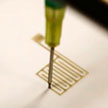 Most printed electronics applications rely on some kind of ink formulated with conductive nanomaterials. Researchers have now introduced a rapid and facile method to fabricate a foldable capacitive touch pad using silver nanowire inks. The team developed a technique that uses a 2D programmed printing machine with postdeposition sintering using a camera flash light to harden the deposited silver nanowire ink. resulting paper-based touchpads produced by direct writing with silver nanowire inks offer several distinct advantages over existing counterparts.
Most printed electronics applications rely on some kind of ink formulated with conductive nanomaterials. Researchers have now introduced a rapid and facile method to fabricate a foldable capacitive touch pad using silver nanowire inks. The team developed a technique that uses a 2D programmed printing machine with postdeposition sintering using a camera flash light to harden the deposited silver nanowire ink. resulting paper-based touchpads produced by direct writing with silver nanowire inks offer several distinct advantages over existing counterparts.
Nov 24th, 2014
 Researchers have demonstrated ultra-stretchability in monolithic single-crystal silicon. The design is based on an all silicon-based network of hexagonal islands connected through spiral springs. The resulting single-spiral structures can be stretched to a ratio more than 1000%, while remaining below a 1.2% strain. Moreover, these network structures have demonstrated area expansions as high as 30 folds in arrays. This method could provide ultra-stretchable and adaptable electronic systems for distributed network of high-performance macro-electronics especially useful for wearable electronics and bio-integrated devices.
Researchers have demonstrated ultra-stretchability in monolithic single-crystal silicon. The design is based on an all silicon-based network of hexagonal islands connected through spiral springs. The resulting single-spiral structures can be stretched to a ratio more than 1000%, while remaining below a 1.2% strain. Moreover, these network structures have demonstrated area expansions as high as 30 folds in arrays. This method could provide ultra-stretchable and adaptable electronic systems for distributed network of high-performance macro-electronics especially useful for wearable electronics and bio-integrated devices.
Oct 21st, 2014
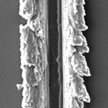 As we are moving into an era of flexible and wearable electronic devices, one challenge that arises is an increased vulnerability to mechanical failure. Relatively small damages such as tiny cracks along the electrical conductive pathway caused by the bending, twisting and folding of such devices could easily cause the entire gadget to fail. Researchers have now demonstrated light-powered healing of an electrical conductor. They show that green light even with low intensity has potential to provide fast and repetitive recovery of a damaged electrical conductor without any direct invasion.
As we are moving into an era of flexible and wearable electronic devices, one challenge that arises is an increased vulnerability to mechanical failure. Relatively small damages such as tiny cracks along the electrical conductive pathway caused by the bending, twisting and folding of such devices could easily cause the entire gadget to fail. Researchers have now demonstrated light-powered healing of an electrical conductor. They show that green light even with low intensity has potential to provide fast and repetitive recovery of a damaged electrical conductor without any direct invasion.
Sep 24th, 2014
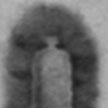 The flexibility required when fabricating flexible electronic components has led to the use of plastic substrates and different transfer techniques to fabricate flexible devices. However, one of the biggest obstacles to mass adoption of flexible electronics has been the incompatibility with industry's state-of-the-art silicon-based CMOS processes. Researchers have now developed a new process that can be used to reduce the thickness of the silicon substrate until the required flexibility is obtained. In new work, they demonstrate a flexible (0.5 mm bending radius) nanoscale FinFET on silicon-on-insulator using a back-etch based substrate thinning process.
The flexibility required when fabricating flexible electronic components has led to the use of plastic substrates and different transfer techniques to fabricate flexible devices. However, one of the biggest obstacles to mass adoption of flexible electronics has been the incompatibility with industry's state-of-the-art silicon-based CMOS processes. Researchers have now developed a new process that can be used to reduce the thickness of the silicon substrate until the required flexibility is obtained. In new work, they demonstrate a flexible (0.5 mm bending radius) nanoscale FinFET on silicon-on-insulator using a back-etch based substrate thinning process.
Sep 9th, 2014
 Proton-conducting materials have become important for a wide range of technologies, such as fuel cells, batteries, and biosensors. A great deal of research has been devoted to developing improved and application-specific proton conducting materials. Researchers even developed a proton-based transistor that could let machines communicate with living things. Scientists now have discovered and characterized novel electrical properties for the cephalopod structural protein reflectin.
Proton-conducting materials have become important for a wide range of technologies, such as fuel cells, batteries, and biosensors. A great deal of research has been devoted to developing improved and application-specific proton conducting materials. Researchers even developed a proton-based transistor that could let machines communicate with living things. Scientists now have discovered and characterized novel electrical properties for the cephalopod structural protein reflectin.
Jun 11th, 2014
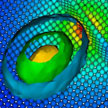 As we are approaching the post-CMOS area, device architectures that are drastically different from today's semiconductor chips are being proposed by researchers. New design concepts are now focused on devices that have not to work despite the presence of quantum effects, but because of them. Solotronics is a relatively new field of optoelectronics that aims to exploit quantum effects at the ultimate limits of miniaturization. This technology seeks to provide a possibility to create in a controllable manner - and to manipulate - single dopants in solids in order to develop optoelectronic devices with only one dopant. To do that, it addresses single dopants placed in a semiconductor material with atomic precision.
As we are approaching the post-CMOS area, device architectures that are drastically different from today's semiconductor chips are being proposed by researchers. New design concepts are now focused on devices that have not to work despite the presence of quantum effects, but because of them. Solotronics is a relatively new field of optoelectronics that aims to exploit quantum effects at the ultimate limits of miniaturization. This technology seeks to provide a possibility to create in a controllable manner - and to manipulate - single dopants in solids in order to develop optoelectronic devices with only one dopant. To do that, it addresses single dopants placed in a semiconductor material with atomic precision.
May 29th, 2014
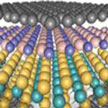 Much hope (and hype) rides on graphene as a 'post-silicon' material for fabricating next-generation nanoelectronic devices. However, graphene's Achilles heel is its lack of an energy band gap. Therefore, graphene must be modified to produce a band gap, if it is to be used in electronic devices. Using a new approach, researchers now have demonstrated the operation of an all two-dimensional transistor, using a transition metal dichalcogenides channel material, hexagonal boron nitride gate dielectric, and graphene source/drain and gate contacts.
Much hope (and hype) rides on graphene as a 'post-silicon' material for fabricating next-generation nanoelectronic devices. However, graphene's Achilles heel is its lack of an energy band gap. Therefore, graphene must be modified to produce a band gap, if it is to be used in electronic devices. Using a new approach, researchers now have demonstrated the operation of an all two-dimensional transistor, using a transition metal dichalcogenides channel material, hexagonal boron nitride gate dielectric, and graphene source/drain and gate contacts.
May 13th, 2014
 The growing market of power electronics creates new challenges for engineers and material specialists as it requires devices withstanding increasingly high voltages and for this new approaches to design and the adoption of new materials such as gallium nitride (GaN) and silicon carbide (SiC) are needed. The biggest point of attention for power electronics is breakdown voltage, that is, the highest voltage applicable to the device before it breaks down and starts to become non-functional.
The growing market of power electronics creates new challenges for engineers and material specialists as it requires devices withstanding increasingly high voltages and for this new approaches to design and the adoption of new materials such as gallium nitride (GaN) and silicon carbide (SiC) are needed. The biggest point of attention for power electronics is breakdown voltage, that is, the highest voltage applicable to the device before it breaks down and starts to become non-functional.
May 12th, 2014
 Most printed electronics applications rely on some kind of ink formulated with conductive nanomaterials. Researchers have now introduced a rapid and facile method to fabricate a foldable capacitive touch pad using silver nanowire inks. The team developed a technique that uses a 2D programmed printing machine with postdeposition sintering using a camera flash light to harden the deposited silver nanowire ink. resulting paper-based touchpads produced by direct writing with silver nanowire inks offer several distinct advantages over existing counterparts.
Most printed electronics applications rely on some kind of ink formulated with conductive nanomaterials. Researchers have now introduced a rapid and facile method to fabricate a foldable capacitive touch pad using silver nanowire inks. The team developed a technique that uses a 2D programmed printing machine with postdeposition sintering using a camera flash light to harden the deposited silver nanowire ink. resulting paper-based touchpads produced by direct writing with silver nanowire inks offer several distinct advantages over existing counterparts.
 Subscribe to our Nanotechnology Spotlight feed
Subscribe to our Nanotechnology Spotlight feed





